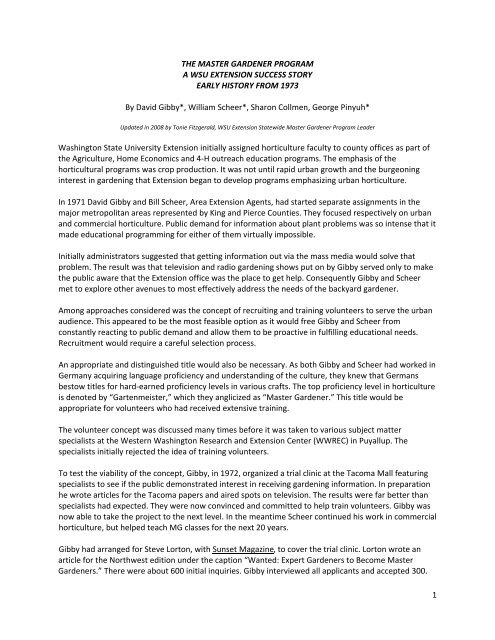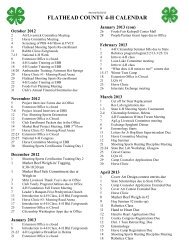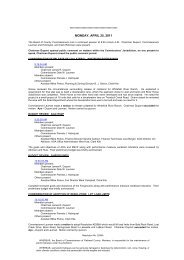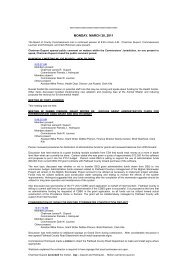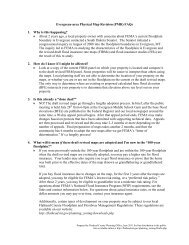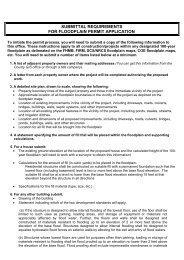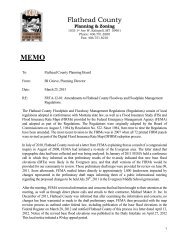The History of the Master Gardener Program
The History of the Master Gardener Program
The History of the Master Gardener Program
Create successful ePaper yourself
Turn your PDF publications into a flip-book with our unique Google optimized e-Paper software.
THE MASTER GARDENER PROGRAM<br />
A WSU EXTENSION SUCCESS STORY<br />
EARLY HISTORY FROM 1973<br />
By David Gibby*, William Scheer*, Sharon Collmen, George Pinyuh*<br />
Updated in 2008 by Tonie Fitzgerald, WSU Extension Statewide <strong>Master</strong> <strong>Gardener</strong> <strong>Program</strong> Leader<br />
Washington State University Extension initially assigned horticulture faculty to county <strong>of</strong>fices as part <strong>of</strong><br />
<strong>the</strong> Agriculture, Home Economics and 4‐H outreach education programs. <strong>The</strong> emphasis <strong>of</strong> <strong>the</strong><br />
horticultural programs was crop production. It was not until rapid urban growth and <strong>the</strong> burgeoning<br />
interest in gardening that Extension began to develop programs emphasizing urban horticulture.<br />
In 1971 David Gibby and Bill Scheer, Area Extension Agents, had started separate assignments in <strong>the</strong><br />
major metropolitan areas represented by King and Pierce Counties. <strong>The</strong>y focused respectively on urban<br />
and commercial horticulture. Public demand for information about plant problems was so intense that it<br />
made educational programming for ei<strong>the</strong>r <strong>of</strong> <strong>the</strong>m virtually impossible.<br />
Initially administrators suggested that getting information out via <strong>the</strong> mass media would solve that<br />
problem. <strong>The</strong> result was that television and radio gardening shows put on by Gibby served only to make<br />
<strong>the</strong> public aware that <strong>the</strong> Extension <strong>of</strong>fice was <strong>the</strong> place to get help. Consequently Gibby and Scheer<br />
met to explore o<strong>the</strong>r avenues to most effectively address <strong>the</strong> needs <strong>of</strong> <strong>the</strong> backyard gardener.<br />
Among approaches considered was <strong>the</strong> concept <strong>of</strong> recruiting and training volunteers to serve <strong>the</strong> urban<br />
audience. This appeared to be <strong>the</strong> most feasible option as it would free Gibby and Scheer from<br />
constantly reacting to public demand and allow <strong>the</strong>m to be proactive in fulfilling educational needs.<br />
Recruitment would require a careful selection process.<br />
An appropriate and distinguished title would also be necessary. As both Gibby and Scheer had worked in<br />
Germany acquiring language pr<strong>of</strong>iciency and understanding <strong>of</strong> <strong>the</strong> culture, <strong>the</strong>y knew that Germans<br />
bestow titles for hard‐earned pr<strong>of</strong>iciency levels in various crafts. <strong>The</strong> top pr<strong>of</strong>iciency level in horticulture<br />
is denoted by “Gartenmeister,” which <strong>the</strong>y anglicized as “<strong>Master</strong> <strong>Gardener</strong>.” This title would be<br />
appropriate for volunteers who had received extensive training.<br />
<strong>The</strong> volunteer concept was discussed many times before it was taken to various subject matter<br />
specialists at <strong>the</strong> Western Washington Research and Extension Center (WWREC) in Puyallup. <strong>The</strong><br />
specialists initially rejected <strong>the</strong> idea <strong>of</strong> training volunteers.<br />
To test <strong>the</strong> viability <strong>of</strong> <strong>the</strong> concept, Gibby, in 1972, organized a trial clinic at <strong>the</strong> Tacoma Mall featuring<br />
specialists to see if <strong>the</strong> public demonstrated interest in receiving gardening information. In preparation<br />
he wrote articles for <strong>the</strong> Tacoma papers and aired spots on television. <strong>The</strong> results were far better than<br />
specialists had expected. <strong>The</strong>y were now convinced and committed to help train volunteers. Gibby was<br />
now able to take <strong>the</strong> project to <strong>the</strong> next level. In <strong>the</strong> meantime Scheer continued his work in commercial<br />
horticulture, but helped teach MG classes for <strong>the</strong> next 20 years.<br />
Gibby had arranged for Steve Lorton, with Sunset Magazine, to cover <strong>the</strong> trial clinic. Lorton wrote an<br />
article for <strong>the</strong> Northwest edition under <strong>the</strong> caption “Wanted: Expert <strong>Gardener</strong>s to Become <strong>Master</strong><br />
<strong>Gardener</strong>s.” <strong>The</strong>re were about 600 initial inquiries. Gibby interviewed all applicants and accepted 300.<br />
1
Recollections vary as to how many people were actually trained. A fair figure would be about 200. Ed<br />
Hume, media gardening expert, was an honorary trainee. He provided valuable help in advertising <strong>the</strong><br />
program and continues to do so.<br />
<strong>The</strong> next step was to develop a training curriculum. Subject matter was to include culture <strong>of</strong> ornamental<br />
plants, lawns, vegetables and fruits; control <strong>of</strong> plant diseases, insects and weeds, and safe use <strong>of</strong><br />
pesticides. Sessions were to be held eight hours per day, one day a week, for five weeks. At <strong>the</strong> end <strong>of</strong><br />
<strong>the</strong> training, volunteers were required to pass subject matter exams, as well as am exam for pesticide<br />
licensing by <strong>the</strong> Washington State Department <strong>of</strong> Agriculture. <strong>Master</strong> <strong>Gardener</strong>s were <strong>the</strong>n committed<br />
to volunteering a specified number <strong>of</strong> hours working with <strong>the</strong> gardening public.<br />
Faculty specialists from <strong>the</strong> WWREC Center and county faculty participated in teaching. <strong>The</strong> first training<br />
sessions in King County took place at <strong>the</strong> Renton Library and in Pierce County at <strong>the</strong> Tacoma Grange Hall<br />
during <strong>the</strong> spring <strong>of</strong> 1973. Later that same year training was provided in <strong>the</strong> eastern Washington city <strong>of</strong><br />
Spokane by Horticulture Extension Agent David Bosley, making <strong>the</strong> new program a statewide endeavor.<br />
Funds in <strong>the</strong> amount <strong>of</strong> $500 were needed to stock <strong>the</strong> first clinics staffed by <strong>Master</strong> <strong>Gardener</strong>s, but<br />
Gibby’s application was turned down by University Extension administration. A second submittal written<br />
by Gibby, and signed by Arlen Davison, Extension Plant Pathologist at <strong>the</strong> WWREC, was eventually<br />
approved.<br />
By <strong>the</strong> end <strong>of</strong> 1973 Gibby resigned from WSU to take leadership in ornamental nursery production with<br />
Weyerhaeuser Company. Sharon Collman, who had been working as program assistant with Gibby,<br />
became King County Extension Agent and continued managing <strong>the</strong> program for several years. She is<br />
credited with building a solid foundation for <strong>the</strong> program, as well as promoting and expanding it. She<br />
held <strong>the</strong> program toge<strong>the</strong>r under <strong>the</strong> hardship <strong>of</strong> long hours during a time <strong>of</strong> budgetary constraints. She<br />
also helped o<strong>the</strong>r Extension <strong>of</strong>fices establish <strong>Master</strong> <strong>Gardener</strong> programs in Washington and in o<strong>the</strong>r<br />
states. During this period <strong>the</strong> Pierce County program was ably guided by Nancy Hibbing, a program<br />
assistant.<br />
About a year after Collman took over, Blair Adams (deceased) was hired to replace Gibby in <strong>the</strong> Area<br />
position. Later, when Adams became <strong>the</strong> Extension Horticulture Specialist at <strong>the</strong> WWREC in Puyallup,<br />
George Pinyuh was hired in 1976 as his replacement and held this position until his retirement in 1994.<br />
Collman <strong>the</strong>n concentrated on training <strong>Master</strong> <strong>Gardener</strong>s in diagnosis <strong>of</strong> plant problems and integrated<br />
pest management. <strong>The</strong> <strong>Master</strong> <strong>Gardener</strong>s, in turn, assisted in processing <strong>the</strong> increased volume <strong>of</strong> plant<br />
problem specimens arriving from <strong>the</strong> expanded number <strong>of</strong> clinics.<br />
In <strong>the</strong> meantime, Bernard Wesenberg (deceased), Extension Ornamental Horticulture Specialist at <strong>the</strong><br />
WWREC, promoted <strong>the</strong> MG program nationwide and took on a significant coordinating role. Davison, by<br />
<strong>the</strong>n State Extension Agriculture and Natural Resources <strong>Program</strong> Leader and later WWREC<br />
Superintendent, promoted <strong>the</strong> program within administration and was responsible for funding <strong>Program</strong><br />
Assistants in various counties.<br />
During <strong>the</strong> long tenure <strong>of</strong> George Pinyuh as Area Extension Agent (Faculty Excellence Award recipient),<br />
<strong>the</strong> program continued to expand in number <strong>of</strong> volunteers, number <strong>of</strong> plant clinics and new volunteer<br />
roles. He also established <strong>the</strong> individual County and State <strong>Master</strong> <strong>Gardener</strong> Foundations. <strong>The</strong> WSU<br />
Extension <strong>Master</strong> <strong>Gardener</strong> Resource Center at <strong>the</strong> University <strong>of</strong> Washington Center for Urban<br />
2
Horticulture is ano<strong>the</strong>r Pinyuh accomplishment. He continues to teach MG volunteers and works at<br />
demonstration gardens.<br />
Mary Robson, after five years <strong>of</strong> being a program assistant with Pinyuh, held <strong>the</strong> Area Extension faculty<br />
from 1994 until 2004. She worked closely with Pinyuh to improve program efficacy and establish a good<br />
working relationship with <strong>the</strong> University <strong>of</strong> Washington.<br />
As time progressed, <strong>the</strong> program received <strong>the</strong> credibility and recognition it well deserved.<br />
It is not possible to name all who have made significant contributions to this program over <strong>the</strong> years.<br />
<strong>The</strong> list includes many faculty members and dedicated program assistants, who started MG programs<br />
statewide and deserve much credit.<br />
In order to better manage <strong>the</strong> urban horticulture educational efforts statewide, a <strong>Master</strong> <strong>Gardener</strong><br />
Volunteer Coordinator position was funded. Van Bobbitt held this post from 1989 to 1998, attaining<br />
excellent results promoting <strong>the</strong> program around <strong>the</strong> state and building fur<strong>the</strong>r support from WSU<br />
administration. <strong>The</strong> position was later held by Rod Tinnemore from 2001 until 2006. In January <strong>of</strong> 2008,<br />
Associate Vice President and Dean <strong>of</strong> WSU Extension, Linda Kirk Fox created for <strong>the</strong> first time a state<br />
<strong>Master</strong> <strong>Gardener</strong> <strong>Program</strong> Leader position within WSU Extension and appointed Tonie Fitzgerald to<br />
provide leadership on a statewide basis.<br />
<strong>The</strong>re are now over 4000 <strong>Master</strong> <strong>Gardener</strong> volunteers across <strong>the</strong> state. <strong>The</strong>y staff plant clinics in 105<br />
communities at 171 locations. Each <strong>Master</strong> <strong>Gardener</strong> received approximately 60 hours <strong>of</strong> training and<br />
volunteers a minimum <strong>of</strong> 50 hours as a community educator in his or her community. <strong>The</strong>y extend <strong>the</strong><br />
service <strong>of</strong> <strong>the</strong> University to more than 500,000 people each year. Some have served actively in <strong>the</strong><br />
program for more than 20 years.<br />
<strong>The</strong> horticulture “<strong>Master</strong>” volunteer concept is so effective that it has spread throughout <strong>the</strong> United<br />
States and several provinces <strong>of</strong> Canada. It has been adopted by various o<strong>the</strong>r disciplines <strong>of</strong> WSU<br />
Extension such as food preservation, animal husbandry and resource conservation, e.g. <strong>Master</strong> Food<br />
Preserver and Safely Advisors, Livestock Advisors, <strong>Master</strong> Composters, and Beach Watchers<br />
*Ex‐Faculty and Faculty Emeritus, WSU Extension, King and Pierce Counties<br />
3


